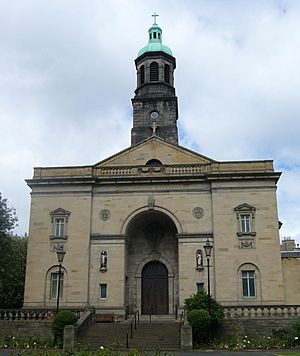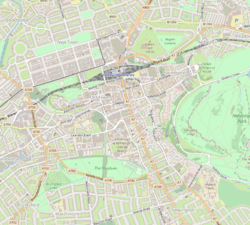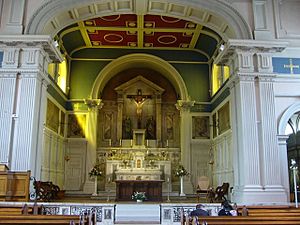St Patrick's Church, Edinburgh facts for kids
Quick facts for kids St Patrick's Church |
|
|---|---|
 |
|
| 55°56′59″N 3°11′05″W / 55.9498°N 3.1846°W | |
| Location | Old Town, Edinburgh |
| Country | United Kingdom |
| Denomination | Roman Catholic |
| Website | St Patrick's Parish, Edinburgh |
| History | |
| Status | Parish church |
| Dedication | Saint Patrick |
| Events | Facade added in 1929 |
| Architecture | |
| Functional status | Active |
| Heritage designation | Category B listed |
| Designated | 14 December 1970 |
| Architect(s) | John Baxter, James Graham Fairley and Reginald Fairlie |
| Style | Neoclassical |
| Groundbreaking | 1772 |
| Completed | 1774 |
| Construction cost | £4,000 |
| Administration | |
| Deanery | St Giles |
| Archdiocese | St Andrews and Edinburgh |
| Province | St Andrews and Edinburgh |
St Patrick's Church is a Catholic church in Edinburgh, Scotland. It is located in the historic Old Town, near the Cowgate area. This beautiful church was built a long time ago, between 1771 and 1774. It became a Catholic church in 1856. The front of the church, called the facade, was updated in 1929. It is an important building, recognized as a Category B listed building.
Contents
History of St Patrick's Church
St Patrick's Church has a long and interesting history. It started as a different kind of church before becoming the Catholic church it is today.
Before the Church Was Built
Records show that the land where the church stands was mostly empty in the early 1500s. Important people owned parts of this land over the years. For example, Archbishop James Beaton bought some of it in 1509. Later, a servant of Mary Queen of Scots, Francisco de Busso, owned a section.
In the late 1600s, a judge named Sir James Elphinstone built a court building here. Then, in 1770, a group called the Episcopal Congregation bought most of the land. They wanted to build a new church, which became known as the Cowgate Chapel.
Building the Original Church
The original church was designed by an architect named John Baxter. Construction began in June 1772 and finished in 1774. It was first used by the Scottish Episcopal Church.
In 1818, the building was taken over by the United Presbyterian Church. The Scottish Episcopal Church had hired an artist, Alexander Runciman, to paint murals inside. These paintings were covered up by the new Presbyterian congregation. They were forgotten for many years.
Rediscovering the Murals
In the 1960s, an art historian named Duncan Macmillan found out about the hidden murals. Since then, some of these paintings have been uncovered. You can see them on the east side of the church's apse. They show stories like the Parable of the Prodigal Son and Jesus with the Samaritan Woman. As of August 2025, work to restore these murals is still ongoing.
Becoming a Catholic Church
In 1856, the church building was bought by Bishop James Gillis for the Catholic Church. The cost was £4,000. Half of this money came from the local church community, and the other half from the Catholic Church. On August 3, 1856, the church officially opened with a special Mass led by Bishop Gillis.
Church Additions and Changes
Over the years, St Patrick's Church has been expanded and updated. In 1898, the sanctuary area was redesigned, and a new main altar was added. This work was designed by James Graham Fairley.
A special chapel was built in 1921 to remember the church members who died in World War I. From 1924 to 1925, two more chapels were built: the Lady Chapel and the Sacred Heart Chapel. In 1929, the impressive front of the church, called the facade, was built. It was designed by Reginald Fairlie and includes statues of St Patrick and St Brigid.
Recent Changes
In 2001, priests from a group called the Redemptorists began serving the parish. After 13 years, in November 2014, the Redemptorists left. The parish then returned to the care of the Archdiocese of St Andrews and Edinburgh.
In September 2023, a new group of priests moved into the church. They are exploring a community life similar to the Oratorian tradition.
Archaeological Discoveries
From 2006 to 2007, archaeologists from Headland Archaeology dug up parts of the church grounds. This was done before a new hotel was built nearby. These digs helped us learn about the history of the Cowgate area.
They found evidence that flash floods used to sweep through this part of Cowgate. This happened until Edinburgh started to develop as a town around the 11th and 12th centuries. In the 14th century, a large ditch was dug across the site. This ditch was likely part of the medieval town's boundary. It was used as a smelly rubbish dump. Later, the ditch was filled in, and buildings were constructed on the site from the 17th century onwards, before the church was built.
Important People Connected to St Patrick's
Many notable individuals have been associated with St Patrick's Church:
- Canon Edward Joseph Hannan (1836-1891) led the church for most of his life. He also helped found the Hibernian Football Club during this time.
- Canon John Gray (1866-1934) was a poet and priest. He was a friend of Oscar Wilde and later founded St Peter's Church in Morningside.
- Margaret Sinclair (1900-1925) was a nun. She was declared "Venerable" in 1978, which is a step towards becoming a saint. Her national shrine is located within St Patrick's Church.
- James Connolly (1868-1916) was an Irish revolutionary. He was born in Scotland to Irish parents.
The Parish and Community
The community around St Patrick's Church is very active. On August 6, 1875, the Hibernian Football Club (Hibernian F.C.) was founded. This happened at the Catholic Institute, also known as St. Mary's Street Halls. It was started by the St Patrick's Catholic Young Men Society (CYMS). The parish priest, Father Edward Joseph Hannan, and Michael Whelahan from the CYMS decided to create the football club.
On St Patrick's Day, March 17, 2013, a special plaque was given to the church. It was presented by the Hibernian Supporters Club to remember the founding of the football club.
The church holds three Sunday Masses for its community. These are at 9:00 AM, 11:00 AM, and 4:30 PM every Sunday.
See also
- Roman Catholic Archdiocese of St Andrews and Edinburgh



